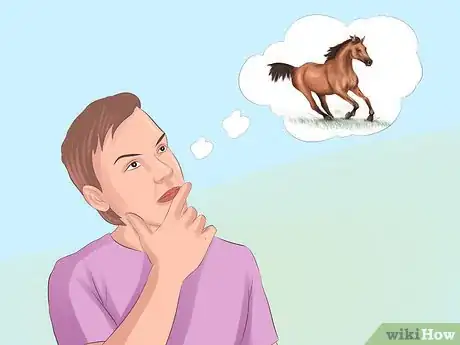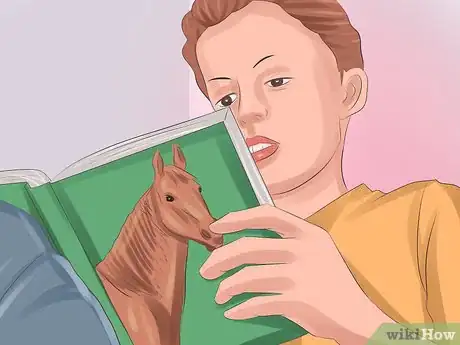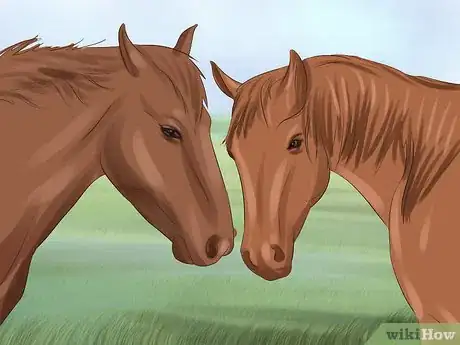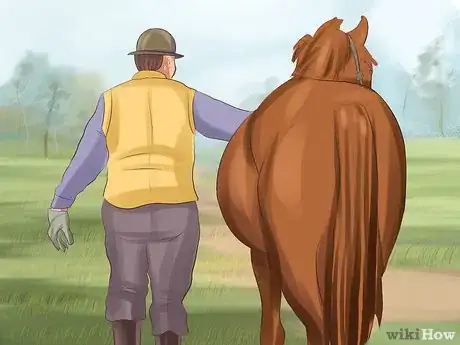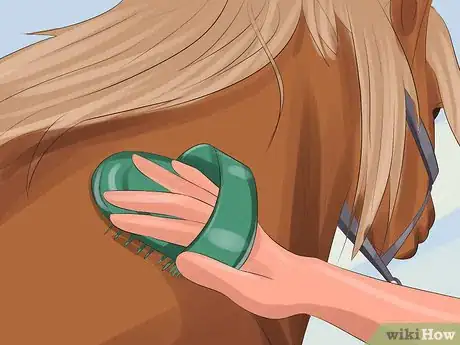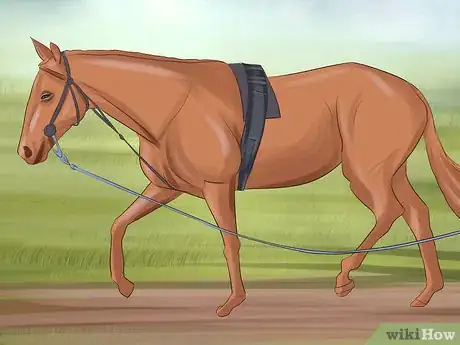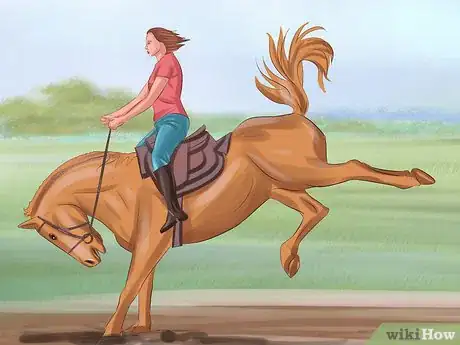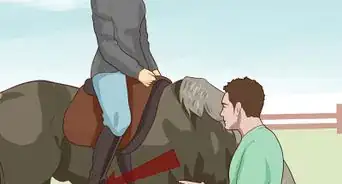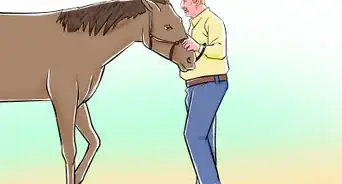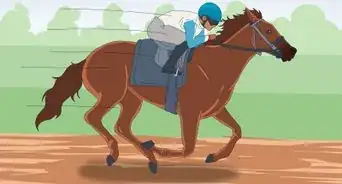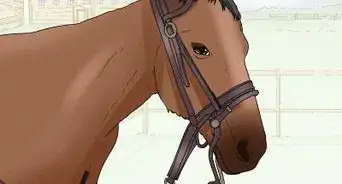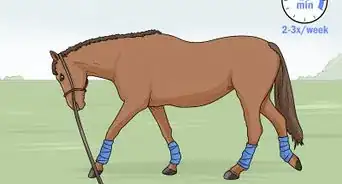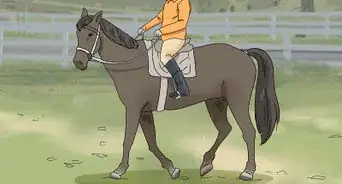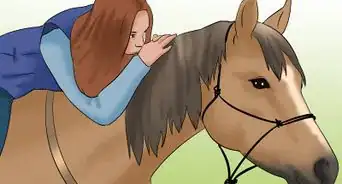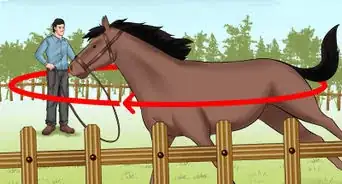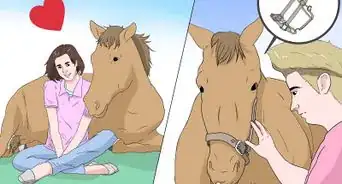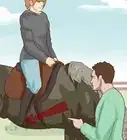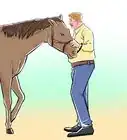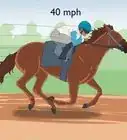This article was co-authored by Alana Silverman. Alana Silverman is a Certified EAGALA (Equine Assisted Growth and Learning Association) Equine Specialist and the Assistant Manager of Paddock Riding Club, a 200-horse premier equestrian facility based in Los Angeles, California. Alana has over 25 years of experience caring for and riding horses and specializes in English riding and riding instruction. She has a BA in Psychology from the University of Arizona.
There are 8 references cited in this article, which can be found at the bottom of the page.
This article has been viewed 33,060 times.
Taming a young or unbroken horse or pony can be a fun challenge, but it can be frustrating too. A very important thing to remember is to be patient. You two can't communicate through language, so teaching him or her with body language is a must. This can take as few as a month or two, or as long as a year.
Steps
Getting Started
-
1Put yourself in the horses shoes. If suddenly there was a stranger trying to put something on your back, put leather straps around your face and head, and wanting to get onto your back and control you with a metal device put into your mouth, you would probably be kind of annoyed. Try to keep this in mind as you begin training your horse.
- Remember, this is a very large animal that is scared, could be belligerent and want to hurt you just to get away from you. Your life, and those around you could be in danger. So be smart, find someone who knows what they are doing before you attempt anything close to "taming" this animal. You might just save the horse's life too.
-
2Learn everything you can about the horse you're training. The decision to train a horse should be researched well before the animal is even purchased. Begin with the breeder or owner and find out the "personality" of the horse. Is it friendly and willing? Or is it a man killer in disguise?[1]
- Get a "pre-purchase" examination by a qualified equine veterinarian. Your vet specialist can help you to discover any underlying medical problems, joint conditions, dental problems that may impact training regimes. Not every horse is friendly, or going to make a good candidate for training.
Advertisement -
3Make sure your horse is vaccinated, and find out what it has been eating. All horses need to be checked out for health and vaccinated against infectious diseases and other problems unique to horses. Quick changes to nutrition can have a serious effect on the horse's stomach and could lead to serious problems, such as Colic. This is another reason it's essential that you visit a licensed and qualified equine vet before you attempt to train a horse.
-
4Tailor your training method to your riding interests. Horses intended for pleasure riding, simple trail riding, long distance riding, athletic events, or high level competition like polo or barrel racing need to be trained differently. Likewise, horses being used for work such as cattle cutting need special training, as well. Match your horse with techniques that will blend well with your intended purpose, the breed of the animal, and what you expect the animal to accomplish for you.
- There is a huge spectrum of training. From Dressage to Endurance to Hunting and Jumping to Track Racing, the list is more complicated than possible to get into for the purposes of this article. It's important to consult with experienced trainers where you stable your horse and develop an appropriate plan for your purposes.[2]
-
5Let the horse be around other tamed horses. Put them out in a pasture with a very patient horse. Every day, come out with a bucket of oats or treats. The patient horse should come up to you, accepting your treats. Pet the horse and make it clear that the other horse is being treated well. Eventually your horse should start coming to you for these delicious treats too. Stroke your horse, use a kind, warm, and inviting tone, and be very patient.
- After a while, when your horse just starts coming, stop bringing treats. Your horse will eventually come to realize that when you come out, they should too.
Earning a Horse's Trust
-
1Go slowly. Training a horse to accept a person takes patience and common sense. Horses are big animals and can hurt you if you are not paying attention and don't understand how they react to certain things. A horse is a prey animal therefore they are constantly on the lookout for danger as a result they are hyper alert and can run or rear up or kick in self defense so it is best to not make sudden moves around them or "surprise" them.[3]
- That being said it is not hard to gain a horses trust. First you will want to tether your horse with a halter and a lead rope so the horse won't walk away from you. It is always a good idea to have someone who knows about horses with you to help you manage the horse at first.
- The more time you spend with a horse, the more they'll learn to trust you.[4]
-
2Be aware of your surroundings. Horses are large and potentially dangerous animals, so it's important to stay aware at all times when you're handling them. Look for any potential situations that could trigger a fear response.
- Always wear boots and pay attention to where the horse hooves are because you will eventually get stepped on.
- Whenever possible approach your horse from the front or side. Horses have wide angle vision but if you are directly behind them they cannot see you.[5]
- Horses especially enjoy when you approach them from the side and pet their neck or the side of their face.[6]
-
3Let your horse get used to your touch. Hold the lead rope in one hand a gently start rubbing the horse on their neck or between their ears or on their sides. Horses will let you know whether they like it or not by moving closer or moving away from your touch.
- A carrot or some grain in your hand will get their attention. When feeding a horse with your hand give them the flat of your palm not your fingers.[7] Let the horse smell you and get to know you. Run your hands over their back and hind end.
-
4Learn to groom the horse properly. To get comfortable with your horse, a good brushing is essential. Remember to be soft and gentle with your strokes. If you are standing directly behind the horse, they can not see you so it's important to keep talking and maintain contact with the horse with your hands and talk in soft gentle tone.
- If you want to build a bond with your horse brush and stroke it daily, it will go a long way. It is a good idea to begin any ride with 10 minutes of gentle brushing and massaging your horse.[8]
-
5Start by lunging the horse. Once your horse is calm enough, start putting a halter on and start walking the horse around the pasture. Stroll along, and if your horse tries to run away, let them. Eventually, the horse will come back, as they see you mean no harm and don't pose a threat. Eventually, once your hose seems comfortable, ask them to pick up a trot, then canter, then, if you feel up to it, a gallop. Remember to take your time, and that you don't need to ask for the gallop before moving on.
- To begin with, just start bringing a lead rope, but keep strolling around. If your horse seems okay with this, start strolling around other places. You can even go into an arena, so they get used to it.
- Remember not to wrap the lunge line, so if your horse bolts or spooks, you won't be dragged.
- Once your horse can properly perform a walk, trot, canter, and halt in both directions, add a saddle. Keep lunging your horse from a halt to the canter, and gradually add weights to the saddle.
Preparing to Ride
-
1Learn to tie your horse up firmly. Consult more experienced riders for more information about saddling and tacking your horse. Tie the lead rope so it will break away if the horse should spook and pull tightly but otherwise keep the horse tethered. Allow only enough slack in the lead rope to allow her head to move but not enough to touch the ground.
- If your horse is standing too close to you or leaning on you, then push back gently. Horses respond to pressure. So firmly push the horse into position don't ever yank or yell at a horse. You will find that applying pressure will often get a better result.
-
2Saddle the horse. Before saddling up, brush off the area where the pad and saddle will rest on your horses back, being sure no dirt or grit will rub the horse under pressure of your weight in the saddle.[9] Place the pad gently on the horses back after first showing to her and allowing her to smell it. This is important especially if she is fairly new to the process. same with the saddle let the horse see the saddle then place it gently on her back.[10]
- Always use a saddle that you can fit in comfortably. You don't want to feel crammed, but you also don't want the seat to be too big.[11]
- Once the saddle is on, the front should rest on the blanket close to the base of the horses neck and the girth strap should hang just behind her foreleg. When tightening the girth strap gently apply pressure do not jerk the strap.[12]
- Have a friend help you with tying the cinch off and putting on the bridle which takes some practice with placing the bit between the horses teeth without knocking the teeth with the bit.
-
3Learn to read your horse. Every time you come near the horses, you need to take stock of the horse physically and emotionally. Assess the condition of its hooves and legs, as well as the breathing rate. Is the horse calm, or excited and antsy?
- Often there is a good reason for this and you must try to figure it out and fix the problem. Sometimes leading the horse away into a different direction and circling back is enough to get them to cooperate.
- An anxious and frightened horse might have really tense muscles, pointed or pinned-back ears, flared nostrils, and/or wide eyes.[13]
- If the horse approaches you, you can assume that they're curious about you.[14]
-
4Don't expect much from your first ride. Once your horse can perform the gaits in both directions with weights in the saddle, a bit, and reins collected to where a rider's hands would be, your horse is ready to be mounted. Be extremely careful when mountain your horse at first.
- Some horses don't even go forward, but will just back up endlessly while you're on.
- If your horse displays bad habits (bucking, kicking, rearing) after the first few minutes, try being a bit sterner. You want to make it clear that bad habits are a no.
- After thirty minutes, get off. Your rides will get longer with time, but you want your horse to get used to a rider.
Community Q&A
-
QuestionI'm helping train a friend's Shetland pony. She jerks her head up when I ask for a trot. I try to collect her but she just backs up. How can I understand her? I am 11.
 Community AnswerGet help from a professional, or a reputable trainer in your area. In my experience, 11-year-olds should NOT be riding green ponies, or even attempting to train them without an experienced adult to help them. If, and only if you have an adult's help, try keeping soft contact with the pony's mouth and encourage her forward. Untrained horses will not usually collect nicely, so do not expect pretty collection. In order to get the best results from green horses/ponies, simply follow the line of contact. In other words, if the head goes up, the hands follow. The pony is likely backing up because you are putting pressure on her mouth that she does not understand yet. Keep trying and be patient!
Community AnswerGet help from a professional, or a reputable trainer in your area. In my experience, 11-year-olds should NOT be riding green ponies, or even attempting to train them without an experienced adult to help them. If, and only if you have an adult's help, try keeping soft contact with the pony's mouth and encourage her forward. Untrained horses will not usually collect nicely, so do not expect pretty collection. In order to get the best results from green horses/ponies, simply follow the line of contact. In other words, if the head goes up, the hands follow. The pony is likely backing up because you are putting pressure on her mouth that she does not understand yet. Keep trying and be patient! -
QuestionWhat should I do if my horse doesn't want me to ride him?
 Community AnswerFirst, get comfortable with your horse on the ground. Pet and brush him until he's comfortable with your presence. Then, get your horse comfortable with the equipment you need to ride him. Let him feel the saddle on his back for awhile, for example. When you feel like you're ready to start riding your horse, have another experienced rider there to help keep your horse calm and make sure you don't accidentally get injured.
Community AnswerFirst, get comfortable with your horse on the ground. Pet and brush him until he's comfortable with your presence. Then, get your horse comfortable with the equipment you need to ride him. Let him feel the saddle on his back for awhile, for example. When you feel like you're ready to start riding your horse, have another experienced rider there to help keep your horse calm and make sure you don't accidentally get injured. -
QuestionWhat breed is this article specifically referring to?
 Community AnswerThis article does not refer to a specific breed.
Community AnswerThis article does not refer to a specific breed.
Warnings
- This might not work if the horse or pony has been or is abused. You might need even more time and patient effort.⧼thumbs_response⧽
- Never beat the horse or pony if it doesn't come or listens. Everything takes time.⧼thumbs_response⧽
References
- ↑ https://www.albertaanimalhealthsource.ca/content/equine-pre-purchase-exams
- ↑ https://ihearthorses.com/11-samples-of-riding-styles/
- ↑ https://horseandrider.com/blog/gaining-your-horses-trust
- ↑ Alana Silverman. Certified EAGALA Equine Specialist. Expert Interview. 17 March 2020.
- ↑ https://www.equisearch.com/discoverhorses/approaching-a-horse-safely
- ↑ Alana Silverman. Certified EAGALA Equine Specialist. Expert Interview. 17 March 2020.
- ↑ Jessica Rude. Equine Expert. Expert Interview. 18 September 2020.
- ↑ https://www.vetvoice.com.au/ec/pet-ownership/pet-grooming/
- ↑ Alana Silverman. Certified EAGALA Equine Specialist. Expert Interview. 17 March 2020.
- ↑ http://www.cowboyway.com/HowTo/SaddleAHorse.htm
- ↑ Jessica Rude. Equine Expert. Expert Interview. 18 September 2020.
- ↑ Alana Silverman. Certified EAGALA Equine Specialist. Expert Interview. 17 March 2020.
- ↑ Jessica Rude. Equine Expert. Expert Interview. 18 September 2020.
- ↑ Alana Silverman. Certified EAGALA Equine Specialist. Expert Interview. 17 March 2020.
About This Article
To tame your horse or pony, frequently interact with it so it gets used to your smell and touch. For example, tie it to a lead rope and gently rub its neck. Another way to get it used to your touch is by feeding it a carrot or some grain from your hand. When giving your horse a treat, feed it with the flat of your palm, not your fingers, and let your horse smell you. Brushing your horse is an essential part of the taming process, so give it a soft brushing for about 10 minutes every day. Make sure you’re not standing directly behind your horse as you brush because you want it to see you and hear your voice so it can form a bond with you specifically. For more help, like how to get your horse ready to ride, read on!
